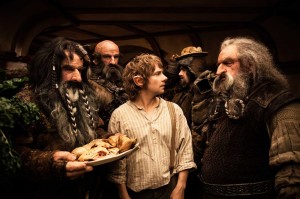Everyone is talking about shooting the new Peter Jackson film, The Hobbit: An Unexpected Journey in 48 frames per second – as opposed to the normal 24 fps – and what the doubled frame rate does to enhance the 3D in the movie, but just as new and unusual is mixing the sound in the Dolby Atmos format. The innovative format has capabilities for up to 64 independent channels, so the audio is not only heard in front, behind and to the sides, but above and below as well.
“We had done the basic mix in 7.1 and 5.1, and then we did the mix in the Atmos format,” re-recording mixer on the picture Michael Semanick explained. “With that format, we got to separate out things a little more and bring things out into the room in spots. For example, in the Goblins cavern, Peter always wanted it to feel like a nightmare in there for our heroes. We were able to put those voices yelling at them all around, above and below, so you really feel you are right there with them, surrounded and scared, but for it not to be real loud. There was no dialog in that capture scene, but later there was, so we had to be careful to not muddy the mix and bury the dialog. The Atmos system is so new, it takes a bit of getting used to and experimentation.”

Semanick emphasized they wanted to enhance the story, not distract from it or make it gimmicky. “I know all of these elements – both visual effects and sound – help tell the story, but if it calls attention too much to itself, then I think we lose the audience,” said Semanick. “For me, what we really are doing with movies is ‘campfire stories’ with pictures.”
Semanick’s favorite scene, and the one he is most proud of, is the scene where Bilbo meets Gollum and first acquires the ring. “There’s something about that scene. Perhaps it’s because the acting is so strong between those two actors,” Semanick offered. “Or it’s the ambience of the cave, the starkness of it, and the stillness at times and yet there are those music moments. People will say, ‘There’s hardly anything in that scene,’ but if you peeled back the layers, you’d find an immense amount of sound. Quiet scenes are almost always harder for me than action scenes.”
That would explain why the most difficult scene to mix was the flashback to Erebor when the Dwarven kingdom, overrun by evil Orcs, falls in an epic fight. It contained both a quiet voiceover and a deafening conflict. “There is a voiceover that is kind of a memory,” said Semanick. “We struggled with that a long time. We did it many different ways to get just the right sound and effect we wanted.” Because the story hinges on fully understanding the dialog, placing that quiet voiceover over a monstrous battle complete with bombastic sound effects and heroic music was a challenge that the mixing team gracefully overcame.





